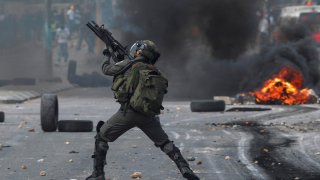The Gaza Dilemma: Israel's Complex Road to Victory Amidst Calls for Ceasefire
Refugees in Gaza, Hezbollah’s looming presence in the north, and Hamas’ reckless defense pose difficult riddles for Israel's war effort
Five months of war between Israel and Hamas has led to Israel defeating Hamas in many parts of Gaza. However, Israel’s path to victory is still complex and uncertain as Hamas has retreated to an area along the Egyptian border. The longer the war goes on, the more there are calls for a ceasefire and humanitarian pause in the fighting. However, neither of Israel’s primary goals in Gaza have been met: the total defeat of Hamas and the release of the remaining hostages.
Meanwhile, Israel continues to face threats from the Iranian-backed terrorist group Hezbollah in Lebanon. Hezbollah has launched thousands of rocket and anti-tank missile attacks on Israel since October 7. Hezbollah also continues to strike at sensitive military sites in northern Israel, including an Israel Defense Forces (IDF) base on Mount Meron and the headquarters of IDF Northern Command in Safed. Pro-Iran media also continues to claim that Hezbollah is striking communications and surveillance sites along Israel’s northern border. The message is clear: Hezbollah is saying it knows how to target Israel’s military and it can increase the attacks if necessary.
Israel is now fighting on multiple fronts, including in Gaza, and retaliating against Hezbollah attacks. Israel is also fighting armed groups in the West Bank, particularly the Iranian-backed Palestinian Islamic Jihad. Iranian-backed groups in Syria and Iraq also threaten Israel and U.S. forces, and the Houthis in Yemen are attacking ships in the Red Sea. Israel has sought to manage all these fronts, ignoring the Houthi threats while U.S. Central Command and U.S. partners try to defend shipping in the Red Sea and keeping the Hezbollah front on low heat.
The focus on fighting Hamas in Gaza has diminishing returns. First of all, the IDF has redeployed many units out of Gaza. These include reserve units that made up the bulk of the fighting force called up after the Hamas attack on October 7. Around 300,000 reservists were called up, and Israel put nine divisions in the field, sending five to fight in Gaza and three to stand guard in the north. With the reservists now taking time off, there are three divisions in Gaza. Israeli units now control a corridor across central Gaza that essentially splits the Gaza Strip in two. In the south, the Ninety-Eighth Division is fighting Hamas in Khan Younis, where it has been fighting since early December. Meanwhile, the 162nd Division continues to sweep areas in the north, re-entering areas where the IDF had already fought in November.
For instance, the IDF said on March 3 that it had been fighting in Zaytun, a neighborhood southwest of Gaza City. “During the operational activities, the soldiers eliminated over 100 terrorists and located and destroyed over 35 terrorist infrastructure belonging to Hamas and Islamic Jihad, including weapons storage and manufacturing facilities,” the IDF said.
Meanwhile, in Khan Younis, the IDF said that “the 98th Division carried out an extensive series of strikes on terror targets in western Khan Yunis in order to intensify operational achievements in the area. During the strikes, the troops destroyed terrorist infrastructure and eliminated Hamas terrorists who were operating from civilian facilities in urban areas. The divisional operation started with a series of aerial strikes on approximately 50 terror targets within six minutes, carried out by the Israel Air Force with the assistance of IDF artillery.”
These are essential operations, but they are against a diminished force of Hamas operatives. What that means is that Israel is essentially grinding down Hamas in these areas so that it has total freedom to operate. These tactics have been compared to how Israel manages conflict in the West Bank, where the IDF conducts raids into areas like Jenin often at night, eliminating a few targeted enemies and then withdrawing.
The challenge in Gaza is that it is not the West Bank. The West Bank Palestinian cities are run by the Palestinian Authority, whose security forces are supported by the United States and the West. In Gaza, Hamas ruled the area until it attacked Israel on October 7, and Israel responded with a ground invasion. So far, there has been no alternative put forward to Hamas in Gaza. Israel is vague on its “day after” plans for the war.
The result in Gaza is that there are now more than a million displaced people in Rafah near the Egyptian border, where the last Hamas battalions are also concentrated. Separating the civilians from Hamas is the only way to fight the Hamas battalions. The IDF has sought throughout the war in Gaza to act slowly on the ground, warning civilians, dropping leaflets from C-130s, and even making phone calls to help Gazans evacuate. These efforts also give Hamas the chance to leave areas before they are targeted. It’s not clear how people from Rafah could be moved to another area of Gaza, considering that many of them have fled from other areas of Gaza to Rafah already.
In northern Gaza, a curtain is rising, unveiling the challenges ahead. On February 29, the IDF enabled a humanitarian aid convoy of trucks to enter Gaza north, where some 300,000 civilians continue to live. The people rushed the trucks, and a stampede occurred in which more than 100 people were killed and over 700 injured. This led the White House to say it would act to airdrop aid to northern Gaza. Airdrops were already being used as part of a Jordanian-led initiative that has gone on for months. The number of airdrops is increasing, with the United States carrying out its first airdrop on March 2, when C-130s dropped more than 30,000 meals to Gazan refugees.
Israel is faced with some of its most difficult decisions of the war yet. Israeli leaders have vowed to defeat Hamas, but the group is still in control of Rafah and continues to control the aid that entered Gaza via southern Gaza. It is trying to return to northern Gaza. With a power vacuum in the north, the chaos there will lead some to conclude that Hamas is an alternative to the current state of affairs. Solving the vacuum of power issue is vital to prevent Hamas from returning. Israel must also weigh operations in Rafah or along the Egyptian border. Those are two significant questions that will need to be addressed soon. In addition, there is a lack of clarity on future hostage deals with Hamas. The terrorist group appears to be slow playing any agreement, trying to wring concessions from Israel.
Lastly, Israel must decide how to address the Hezbollah threat. Even though Hezbollah has lost more than 200 of its members in clashes with Israel, it believes it can dictate the tempo of operations. Israeli military and political leaders have vowed that the situation must change in the north. They don’t want Hezbollah carrying out endless attacks with impunity. They also want its rocket and missile squads to be moved away from the border and pushed back into Lebanon some ten to twenty miles. This could be achieved with a political deal or in a scenario where both sides declare victory and save face. For Israel, the main challenge is that more than 50,000 people continue to be evacuated from northern communities, and they won’t go home without assurances that the Hezbollah threat has been dealt with.
With all these challenges ahead, Israel now faces its most complex month of the war in March. These are tough choices that any government would find difficult to make. Israel’s war cabinet, encompassing multiple parties and personalities, will find the decisions even more difficult than a more unified government.
Seth Frantzman is the author of Drone Wars: Pioneers, Killing Machine, Artificial Intelligence and the Battle for the Future (Bombardier 2021) and an adjunct fellow at The Foundation for Defense of Democracies.
Image: Shutterstock.com.


